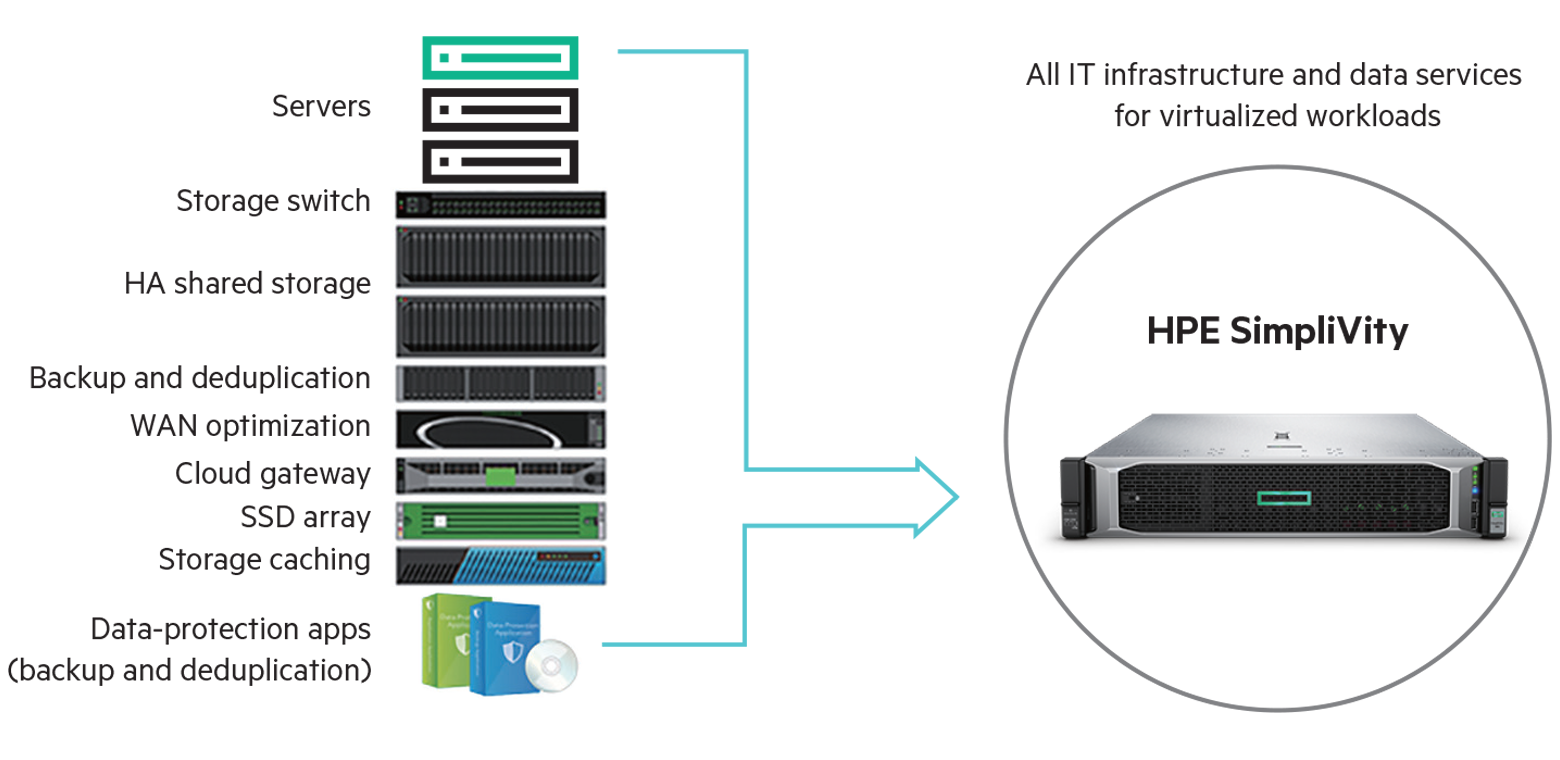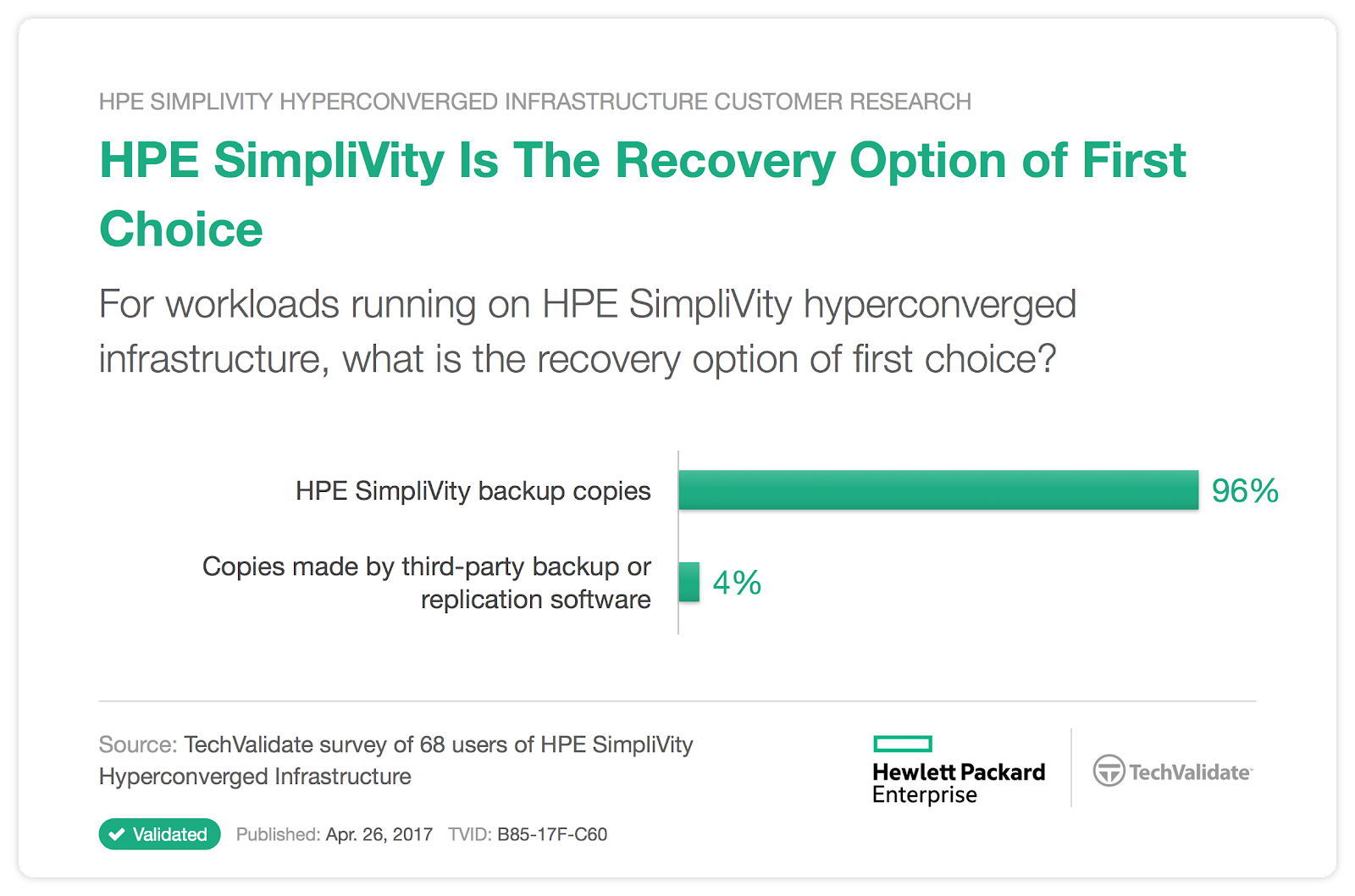The trend over the last 25 years of IT innovation has been to drive down the cost of physical hardware while the ongoing operating costs of operating that hardware with the data center has increased. IDC estimates that in 1995, for every $1 of hardware spending resulted in $0.50 spent on operational expenses like power, cooling, and management. Today, every $1 in hardware generates $4 in operating expenses. That’s an 8-fold increase! As a result, more than ever, IT shops are looking for strategies to reduce operating costs.
One of the most successful approaches to reducing operating costs involves migrating to hyperconverged infrastructure. In hyperconverged environments, compute, network, and storage resources are tightly integrated to deliver a powerful mix of operational cost saving benefits.
HPE SimpliVity is the leading hyperconverged platform on the market today. The operational cost savings available by migrating workloads to HPE SimpliVity, result from benefits in five categories:
- Small Footprint / Low Power Consumption
- Built-in Backup and Recovery Features
- Data Compression and Deduplication Features
- Vendor Consolidation (Hardware, Storage, Network) Opportunity
- IT Staff Efficiency
This post examines each of these categories to help you determine how SimpliVity can help your IT organization streamline and reduce operating expenses.
Small Footprint / Low Power Consumption
Traditional IT infrastructure requires separate equipment for servers, networking, and storage. As illustrated in the diagram below, HPE SimpliVity combines servers, switches, storage, and special purpose devices (e.g., deduplication, caching), into a single building block.

The consolidation of equipment provided by hyperconverged hardware yields impressive space savings, particularly for organizations going through a refresh of aging equipment. For example, when Maryland Auto Insurance replaced the end-of-life HP G5 and G7 servers running their VMware environment, they achieved a significant consolidation by moving to HPE SimpliVity. As Matt Ailstock, IT Systems Manager at Maryland Auto Insurance, stated, “We’ve reduced our infrastructure from seven racks to just half a rack running eight nodes.”
Since most companies lease raised floor data center space to house their IT equipment, reducing the physical footprint of the equipment saves money. Having less equipment also means using less electric power, particularly for heating and cooling.
Achieving these savings are possible for companies large and small. For example, HopgoodGanim, a medium-sized law firm in Australia, states that, “We were using five full kilowatts in our data center alone, but with HPE SimpliVity, we’re down to three kilowatts.”
Collapsing multiple racks of hardware into a smaller package doesn’t just save money on floor space and power, however. In many cases, some specialized equipment becomes completely unnecessary because of features built-in to HPE SimpliVity. For many customers, that’s been the case for backup and recovery.
Built-in Backup and Recovery
Many IT organizations support complex backup and recovery systems that have grown up, piecemeal, over many years. These systems may include virtual machine (VM) snapshots, offsite replication, database mirroring, special-purpose hardware, and cloud backups - with each piece created to address a specific business need.
Managing a patchwork of backup and recovery solutions, to meet business requirements for data protection, remains a time consuming, low value-add, activity in many datacenters.
However, when an organization moves to HPE SimpliVity, they have an opportunity to replace a jumble of backup and recovery components with a built-in data protection solution that requires very little manual oversight.
Data protection is simply a feature of HPE SimpliVity that is built into the architecture. Designed specifically for running virtual machine (VM) workloads, the appliance relies on the HPE SimpliVity Data Virtualization Platform that presents a federation of nodes as a single, pooled, data resource without LUNs, shares, or volumes. All the data within the federation is managed globally in a deduplicated and compressed state. Data protection at the VM level is built-in to this platform. So, you don’t need to know anything about the storage or network architecture to perform backups. In fact, HPE guarantees that you can always restore a 1 TB VM in one minute or less. Policy-driven schedules allow you to manage backups at the VM level. Backup locations can be specified as local, regional, or global.
Customers love these backup and recovery features. According to TechValidate, 96% of surveyed customers use the HPE SimpliVity backup copies as their primary recovery option.
 Source: TechValidate
Source: TechValidateFurthermore, HPE offers a disaster recovery solution, RapidDR, built on top of the existing data protection features. Using RapidDR, your organization can maintain a failover site, running on HPE SimpliVity, that automatically stays in sync with the primary site and ready in the event of an outage.
Another, and more economical, disaster recovery option is to simply replicate the HPE SimpliVity built-in backups to an off-site location or cloud storage. This does not provide the same low recovery time objective (RTO) as a failover site, but if your organization can tolerate some downtime, VMs can be restored, as needed, in the cloud in the event that the primary site goes down. This same approach provides a solution for long-term backup retention.
According to IDC, “94% of the surveyed customers are currently using the built-in data protection features. The impact of HPE SimpliVity data protection features frequently results in reduced use of existing data protection software. Indeed, 55% of survey respondents retired their existing third-party backup or replication software in lieu of HPE SimpliVity data protection features.”
In addition to saving on backup and recovery technology, HPE SimpliVity customers need less labor to manage backups. The business continuity benefits of data protection are significant as well. For example, if the organization is hit by ransomware or a virus, the virtual machines that were affected can be rolled back to the last restore point prior to the attack.
Beyond built-in backup and recovery, HPE SimpliVity provides other great data management features that help your organization to save money on data storage via data compression and deduplication.
Data Compression and Deduplication Features
HPE SimpliVity has built-in deduplication and compression technology that does a tremendous job of economizing on data storage. The concept behind the deduplication technology is straightforward. In any IT infrastructure, there is a ton of duplicated data. For example, if you have 200 people running Windows 10 on 200 VMs, you don’t need to keep 200 copies of each Windows 10 files in data storage. You only really need one copy, or maybe one per cluster, since, for performance reasons, everybody needs to read the files from a geographically close location.
But while the concept of deduplication is simple enough, the implementation is built on sophisticated hardware and computer algorithms. In each HPE SimpliVity 380 appliance, there is an HPE OmniStack Accelerator Card. This is a dedicated PCIe module that handles all read/write operations while simultaneously managing deduplication and compression. In the high-density appliance, the HPE SimpliVity 2600, the OmniStack Accelerator functions are implemented in software, rather than a PCIe card.
Not only does the compression and deduplication technology save data storage, but it also saves on input/output operations per second (IOPS). By not moving around duplicate data, you save a lot of processing and network bandwidth.
This technology has provided customers with astonishing savings in IO and data storage. As the chart indicates, 62% of customers achieve a greater than 50:1 capacity savings.
Maryland Auto Insurance’s IT System Manager Matt Ailstock reports, “We’ve also achieved a 5.5-to-1 dedupe and compression ratio using HPE SimpliVity’s data deduplication functionalities. Previously, we needed almost 50 terabytes of production storage. Now, we’re using half of that.”
Likewise, Aymen Jlassi from Tunisair Technics states, “Our migration of 3.2 terabytes of data was reduced to 500 gigabytes.”
In a study of 7 customers, commissioned by HPE, on average each company “avoided the cost of server and storage hardware of $2,132,130. By implementing six HPE SimpliVity hyperconverged infrastructure nodes, customers avoided major hardware upgrades, retired storage and servers, and avoided the annual maintenance cost on those devices.”
So saving on data and IOPS allows consolidation of hardware, which also enables the consolidation of vendor relationships.
Vendor Consolidation (Hardware, Storage, Network) Opportunity
One of the benefits of hyperconvergence is vendor consolidation. If your hardware, storage, and networking technology have been converged into a single appliance, provided by HPE, you only have one vendor (or partner) to call for support.
In a traditional datacenter, you have server vendor, a network vendor, a storage vendor, and probably also some additional suppliers like a backup and recovery solution vendor. Managing multiple vendors can be time consuming and expensive. It’s like being your own general contractor and each vendor is a subcontractor. When there’s a problem, like a performance bottleneck, you need to figure out which component is causing the problem and what the best solution might be.
That means talking to Dell EMC about the servers (for example), then Cisco about the network (for example), etc. And they often give conflicting advice - which you need to sort out and determine a course of action. That can be time consuming and exasperating.
Problems still arise, of course, in hyperconverged infrastructure, but in this case, you have one primary vendor to deal with: HPE. At this point you may be thinking, “What about VMware (hypervisor), Microsoft (operating system), etc” - we still don’t really have just one vendor relationship. While that’s true, both VMware and Microsoft have alliances with HPE and are included in HPE Enterprise Support. But for integrated support beyond just the major software vendors, there is the HPE Complete program that provides assured interoperability, reliability, and validation of end-to-end infrastructure solutions that integrate smaller third-party vendors providing point solutions for primary storage, replication, virtual GPU, analytics, etc.
In addition to the support benefits of vendor consolidation, your organization can also achieve significant improvements in staff efficiency.
IT Staff Efficiency
A traditional datacenter requires lots of specialized expertise. Server engineers to support the computing hardware. Network engineers to tune and monitor the network. Storage engineers to maintain the data storage systems.
Specialization can be inefficient. Suppose the network engineer is on vacation and there is a major glitch with an important router. Can the storage engineer cover? Probably not if they are specialized and trained to only support the data storage systems.
Part of the problem is that each component (compute, network, storage), and each vendor, has its own administrative interface. The specialists live in those interfaces and have a steep learning curve if they need to jump into another vendor’s admin panel. Too steep of a learning curve to surmount in an emergency. Which is why the storage person cannot easily cover for the networking professional in a pinch.
HPE has solved for this problem by providing a single management interface within the SimpliVity control panel for managing the virtual machines and the network.
For managing the VMs and storage, IT staff leverage the intuitive and familiar VMware vCenter® or Microsoft System Center Virtual Machine Manager - enabling generalists to quickly get up to speed and manage the VM environment using tools that are widely understood.
To provide the same ease-of-use for network administration, HPE has leveraged their Plexxi acquisition (renamed HPE Composable Fabric) to provide a software-defined networking fabric that can be managed from a single portal within the SimpliVity control panel.
As one HPE SimpliVIty customer describes, “One of the aspects [of HPE SimpliVIty] that were especially interesting was the potential for a new division of labor. I had a storage person, a network person, and server people. What if we simply had infrastructure people? What if we all could do more? After all, this is a very small IT shop.”
In another example, the backup manager of one company told the research firm Forrester: “We wanted to be able to manage everything from one place. HPE SimpliVity allows us to manage the entire virtualized environment from vCenter, which was one piece that was compelling us to adopt HPE SimpliVity.”
IIS - Your Partner for HPE SimpliVity
International Integrated Solutions (IIS) is a managed service provider and system integrator with deep expertise in HPE SimpliVity. IIS is a distinguished HPE partner, winning HPE Global Partner of the Year in 2016 and Arrow’s North American Reseller Partner of the Year in 2017.
As your service provider, IIS brings deep expertise and experience. Having solved a myriad of problems for hundreds of customers, they bring a holistic view of the datacenter. This experience makes them well suited to helping you realize the benefits of hyperconvergence with HPE SimpliVity. In particular, IIS can help with:
- Sizing - providing an assessment methodology and tools to spec out your workloads.
- Migration Plans - helping you refresh your hardware and migrate applications to a hyperconverged platform.
- Disaster Recovery Planning - understanding how to meet your business continuity requirements cost-effectively.
- Managed Services - providing remote monitoring and ongoing support for your hyperconverged datacenter.
Hyperconverged Architectures Make Sense Today
Particularly if your organization is facing the need to refresh aging hardware, you should be considering migrating to HPE SimpliVity. Before you invest more money in a traditional architecture with separate compute, network, and storage infrastructure, consider the simplification and cost savings that you can achieve with a hyperconverged solution.








